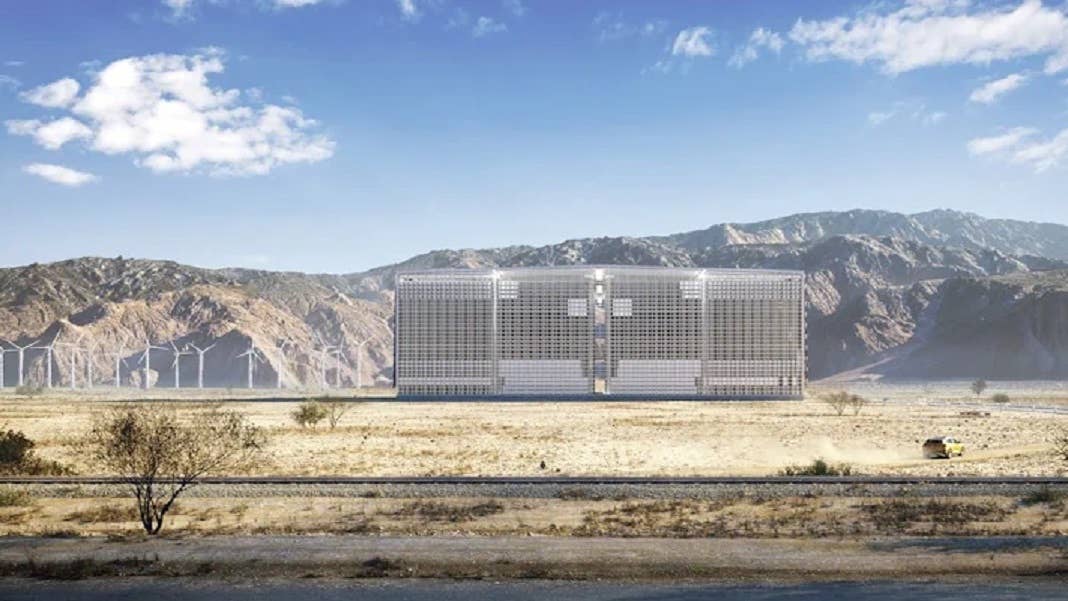Energy Vault’s First Grid-Scale Gravity Energy Storage System Is Near Complete

Share
Swiss startup Energy Vault came out of stealth mode in 2018, and has been on an upward trajectory since then. The company created a system to store electricity by elevating concrete blocks, and investors quickly jumped on board: Energy Vault raised $110 million from the SoftBank Vision Fund in 2019, and another $100 million led by Prime Movers Lab in 2021. It seems they’ve put that funding to good use, because last week the company announced commissioning of their first grid-scale energy storage system outside Shanghai, China.
The system is like a solid version of pumped hydro, which uses surplus generating capacity to pump water uphill into a reservoir. When the water’s released it flows down through turbines, making them spin and generate energy.
Energy Vault’s solid gravity system uses huge, heavy blocks made of concrete and composite material and lifts them up in the air with a mechanical crane. The cranes are powered by excess energy from the grid, which might be created on very sunny or windy days when there’s not a lot of demand. The blocks are suspended at elevation until supply starts to fall short of demand, and when they’re lowered down their weight pulls cables that spin turbines and generate electricity.
Because concrete is denser than water, it takes more energy to elevate it, but that means it’s storing more energy too. The cranes are controlled by a proprietary software that automates most aspects of the system, from selecting blocks to raise or lower to balancing out any swinging motion that happens in the process.
The facility outside Shanghai has a capacity of 100 megawatt hours (MWh); it can continuously discharge 25 megawatts for up to 4 hours. That’s relatively small—for comparison’s sake, the Ludington pumped storage plant in Michigan has a capacity of 1,875 megawatts, which can power a community of about 1.4 million people. Energy Vault says that subsequent gravity storage facilities it plans to build will be able to run at gigawatt-hour scale for 12 hours.
The Shanghai facility was built next to a wind farm and a national grid interconnection site. The company says the facility will have a round-trip efficiency above 80 percent (meaning that 80 percent of the energy expended to lift the blocks will be retained and translated to energy output when the blocks are lowered). That’s comparable to utility-scale batteries and pumped hydro.
Be Part of the Future
Sign up to receive top stories about groundbreaking technologies and visionary thinkers from SingularityHub.


One advantage the gravity system has over batteries, though, is that its storage capacity will stay more consistent over time. Batteries slowly degrade as they charge and discharge, until they become unusable and can be recycled. The gravity system will likely have a longer lifespan than grid-scale batteries, and is more suitable for long-term energy storage—that is, storing excess energy for weeks or months rather than hours or days. This type of storage is going to become more necessary as we increase our reliance on solar and wind power.
Energy Vault IPO’d in February of 2022 through a special-purpose acquisition company deal. The company subsequently came under fire from analysts who said its cost and efficiency claims were flawed. Later in the year, a research firm published a short seller report about the company, later retracting some of the statements made. Energy Vault’s stock price plunged in mid-2022 and has yet to recover.
These setbacks don’t seem to have deterred them too much, though. They recently signed an agreement to build another 100 MWh storage facility in China’s Hebei Province; they’re partnering with Pacific Gas and Electric Company to build a 293 MWh facility in Northern California; and are building a 440 MWh facility near Las Vegas.
Time will tell whether gravity storage is a feasible option to help us transition to renewables. In the meantime, Energy Vault says commissioning of the Shanghai facility will be complete by the end of this year.
Image Credit: Energy Vault
Vanessa has been writing about science and technology for eight years and was senior editor at SingularityHub. She's interested in biotechnology and genetic engineering, the nitty-gritty of the renewable energy transition, the roles technology and science play in geopolitics and international development, and countless other topics.
Related Articles

Startup Zap Energy Just Set a Fusion Power Record With Its Latest Reactor

Scientists Say New Air Filter Transforms Any Building Into a Carbon-Capture Machine

Investors Have Poured Nearly $10 Billion Into Fusion Power. Will Their Bet Pay Off?
What we’re reading